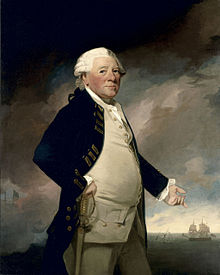HMS Cato (1782)
Theories on her disappearance include her being shipwrecked in locations such as the Malabar Coast and the Maldives, and the crew being murdered by natives.
In the American Revolutionary War the Royal Navy was in need of warships that were small enough to capably operate in the shallow waters around North America, but that were still large enough to provide effective firepower.
[2] By 1780 the extant fourth rates in Royal Navy service were becoming worn, and several had been lost in the years of war.
As such the Grampus ships were not to have the traditional roundhouse, with a set of false stern lights in place to infer otherwise.
[d][17] Having reached South America, Cato left Rio de Janeiro on 12 December and soon disappeared.
Subsequent theories on her fate have included her being shipwrecked off South Arabia, the Malabar Coast, Madagascar, or the Maldives, in around January 1783.
[22] In 1791 the English captain of a vessel belonging to Muhammad Ali Khan Wallajah, the Nawab of Arcot, reported that he had seen stores, including the mainsail, from Cato on a Malay boat at Mecca.
The Malay on the boat stated that a large ship had wrecked some years earlier on the Malabar Coast.
[23] Theories continued to be proposed after this; on 1 November 1805 the East Indiaman Britannia and transport ship King George were wrecked on Rocas Atoll.
[24] Naval historian Sir John Knox Laughton, in his biography of Parker, discards all of the aforementioned theories, arguing that since none of the stories were able to provide any hard evidence of Cato or her crew's fate, it is more likely that the ship accidentally caught fire at sea and blew up.
